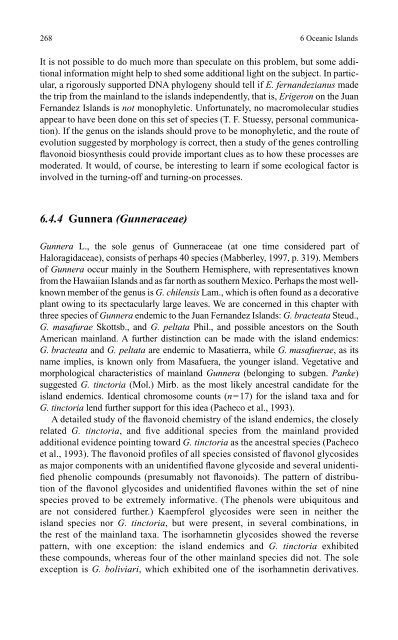The Geography of Phytochemical Races
The Geography of Phytochemical Races
The Geography of Phytochemical Races
Create successful ePaper yourself
Turn your PDF publications into a flip-book with our unique Google optimized e-Paper software.
268 6 Oceanic Islands<br />
It is not possible to do much more than speculate on this problem, but some additional<br />
information might help to shed some additional light on the subject. In particular,<br />
a rigorously supported DNA phylogeny should tell if E. fernandezianus made<br />
the trip from the mainland to the islands independently, that is, Erigeron on the Juan<br />
Fernandez Islands is not monophyletic. Unfortunately, no macromolecular studies<br />
appear to have been done on this set <strong>of</strong> species (T. F. Stuessy, personal communication).<br />
If the genus on the islands should prove to be monophyletic, and the route <strong>of</strong><br />
evolution suggested by morphology is correct, then a study <strong>of</strong> the genes controlling<br />
fl avonoid biosynthesis could provide important clues as to how these processes are<br />
moderated. It would, <strong>of</strong> course, be interesting to learn if some ecological factor is<br />
involved in the turning-<strong>of</strong>f and turning-on processes.<br />
6.4.4 Gunnera (Gunneraceae)<br />
Gunnera L., the sole genus <strong>of</strong> Gunneraceae (at one time considered part <strong>of</strong><br />
Haloragidaceae), consists <strong>of</strong> perhaps 40 species (Mabberley, 1997, p. 319). Members<br />
<strong>of</strong> Gunnera occur mainly in the Southern Hemisphere, with representatives known<br />
from the Hawaiian Islands and as far north as southern Mexico. Perhaps the most wellknown<br />
member <strong>of</strong> the genus is G. chilensis Lam., which is <strong>of</strong>ten found as a decorative<br />
plant owing to its spectacularly large leaves. We are concerned in this chapter with<br />
three species <strong>of</strong> Gunnera endemic to the Juan Fernandez Islands: G. bracteata Steud.,<br />
G. masafurae Skottsb., and G. peltata Phil., and possible ancestors on the South<br />
American mainland. A further distinction can be made with the island endemics:<br />
G. bracteata and G. peltata are endemic to Masatierra, while G. masafuerae, as its<br />
name implies, is known only from Masafuera, the younger island. Vegetative and<br />
morphological characteristics <strong>of</strong> mainland Gunnera (belonging to subgen. Panke)<br />
suggested G. tinctoria (Mol.) Mirb. as the most likely ancestral candidate for the<br />
island endemics. Identical chromosome counts (n = 17) for the island taxa and for<br />
G. tinctoria lend further support for this idea (Pacheco et al., 1993).<br />
A detailed study <strong>of</strong> the fl avonoid chemistry <strong>of</strong> the island endemics, the closely<br />
related G. tinctoria, and fi ve additional species from the mainland provided<br />
additional evidence pointing toward G. tinctoria as the ancestral species (Pacheco<br />
et al., 1993). <strong>The</strong> fl avonoid pr<strong>of</strong>i les <strong>of</strong> all species consisted <strong>of</strong> fl avonol glycosides<br />
as major components with an unidentifi ed fl avone glycoside and several unidentifi<br />
ed phenolic compounds (presumably not fl avonoids). <strong>The</strong> pattern <strong>of</strong> distribution<br />
<strong>of</strong> the fl avonol glycosides and unidentifi ed fl avones within the set <strong>of</strong> nine<br />
species proved to be extremely informative. (<strong>The</strong> phenols were ubiquitous and<br />
are not considered further.) Kaempferol glycosides were seen in neither the<br />
island species nor G. tinctoria, but were present, in several combinations, in<br />
the rest <strong>of</strong> the mainland taxa. <strong>The</strong> isorhamnetin glycosides showed the reverse<br />
pattern, with one exception: the island endemics and G. tinctoria exhibited<br />
these compounds, whereas four <strong>of</strong> the other mainland species did not. <strong>The</strong> sole<br />
exception is G. boliviari, which exhibited one <strong>of</strong> the isorhamnetin derivatives.
















